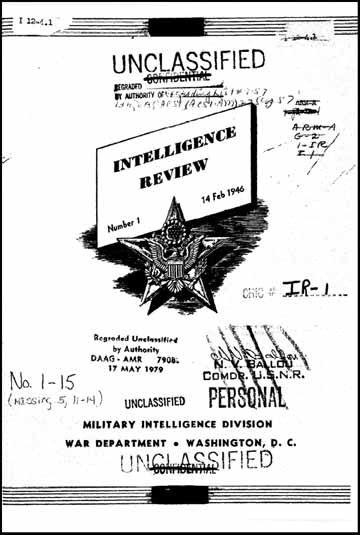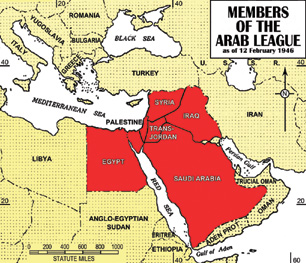In Part 2 of this series, we will continue to examine a 63-year-old military intelligence review from the War Department (now the Department of Defense) archives entitled “Islam: A Threat to World Stability.” Written in a no-holds-barred politically incorrect language not commonly found today, the author establishes a clear and compelling picture of the “Muslim” world of 1946, which elucidates many of the words and concepts today whose meanings may seem blurred or lost in antiquity.
 The intelligence estimate is transposed verbatim in this article. Our Issachar Database (IDB) Folio Manager for Islam (and Military Technology), Ray Sarlin, will then update the intelligence estimate with the corresponding facts and figures for today in the final article. [The entire issue of Intelligence Review No. 1 of 14 February 1946 is available in the Issachar Database.]
The intelligence estimate is transposed verbatim in this article. Our Issachar Database (IDB) Folio Manager for Islam (and Military Technology), Ray Sarlin, will then update the intelligence estimate with the corresponding facts and figures for today in the final article. [The entire issue of Intelligence Review No. 1 of 14 February 1946 is available in the Issachar Database.]
Part 1 of this series (in our October issue) introduced the Muslim world of February 1946, and described its basic motivations. After a brief but interesting look at the history of Islam, it examined four forces in 1946 that tended to weaken Muslim unity: 1) lack of a common language, 2) the Sunni-Shia and other religious schisms, 3) geographic isolation, and 4) economic disparities.
This article will examine two additional major forces tending to weaken Muslim unity and then examine four forces in 1946 that tended to strengthen it.
Forces Tending to Weaken Muslim Unity in 1946(cont.)
5. Political rivalries and nationalism. The Iranian has always looked upon the Arab as a wild man and upon the Turks as a “son of a dog”; the Turk in turn considers the Iranian a degenerate but agrees with his views of the Arab; and so goes the cycle of animosity. These mutual dislikes have existed for centuries, but they have a deeper meaning in the present era of nationalism. For example, after exiling the puppet “Caliph” in 1923, the Turks completely nationalized the idea of Islam. Pilgrimages ceased almost entirely, the Koran was translated into Turkish, and all prayers were put into that language. Oaths no longer needed to be made on the Koran, but on one’s honor. Thus, the roots of Islam were cut, making religion a purely passive phase of nationalism.
Likewise in Iran, during the period from 1920 to 1940, religious holidays were displaced by national fiestas, national heroes were substituted for those of Arab origin, and the old customs of Islam were replaced by new.
Even within the Arab-speaking world, nationalism transcends religion. Egypt is concerned with local issues. Saudi Arabia is absorbed in the age-old feud between its royal family and that of west Arabia. Nationalists in Syria, Lebanon, Tunisia, and Morocco are concentrating on means to throw off the French yoke.
Only when a cause in another region would be of value in their own do the Muslims cooperate. For example, their wide-spread sympathy for the Palestinian Arab in his struggle against Zionism is translated into action only by the Arab states bordering on Palestine. The largest single group of Muslim believers lives in India, but its principal fear is of being swallowed up in a sea of Hindu millions; to these Muslims the establishment of a colony of Jews three thousand miles to the west is by comparison a matter of little concern.
In addition to the dissension and selfish interests that tend to split the Muslim world from within, various foreign countries have parceled into spheres of influence or areas of outright domination. From 1930 to 1940 only three Muslim states, with a total population of less than 40 million people, had any real degree of independence. They were Turkey, Iran, and Saudi Arabia, and each of these was jealous of the others and on the defensive to protect its national existence against the great Powers.
6. Prostitution of leadership. At the end of the 18th century, Muslim Power had fallen so low that a series of self-appointed Protectors of Islam appeared. One of the earliest was Napoleon, who as Governor of Egypt from 1799 to 1802 outdid the old Muslim rulers in celebrating Islamic festivals and reviving decadent customs. Later, Great Britain assumed the role, but her efforts had small success because her Zionist policy antagonized the Arabs.
Then Mussolini and Hitler represented themselves as guardians of the Muslims. Axis money and intrigue proved effective in many instances, so that with the approach of war the Grand Mufti of Jerusalem and Rashid Ali Al Gailani of Iraq, among others, were in the Axis camp. In Iran, a group of important persons was formed into a loose political party which favored the Axis, and in Egypt the British could trust neither the King nor the Premier.
The most recent claimant as Protector of Islam is the Soviet Union, which before the war showed little interest in championing religion but now realizes the value of such a role as an instrument of policy. Thus, while the London BBC and the Delhi radio have recently broadcast recitations in Arabic from the Koran and admonished the faithful to continue their devotions, Radio Moscow has told of the facilities which the Soviet Union had made available to pilgrims for travelling by air to Mecca.
Recent Soviet broadcasts have quoted the Imam of the Moscow Mosque, Sheikh Nasr ad-Din, on freedom of religion in the Soviet Union. The Imam stated that “every Muslim in the U.S.S.R. is well aware of the fact that the Stalin Constitution is a guarantee for the freedom of expression and belief,” and (citing the oppression of Muslims under Christian regimes) that “Muslims in the U.S.S.R. always beseech Allah to protect the Soviet authorities and our great father and friend of all nations, the great and wise Stalin.”
The Imam was also quoted as saying that “as a result of the consideration shown by the Government toward Soviet Muslims, tombs of distinguished Muslim religious leaders are being maintained” and reconstructed. Another Moscow broadcast, directed at Arabic-speaking peoples, declared that rumors circulating in Arab circles regarding the Soviet Union’s attitude toward religion, particularly the Islamic, were “nothing but political maneuvers of the imperialists, who are afraid of the Arab march on the road of democracy and true liberty.”
The election in Moscow of the Grand Mufti of the Central Muslim Administration is reported to have been scheduled for January. Arab circles are reported to have taken more interest in this assembly of Muslims than in any other Soviet propaganda effort. It is to be anticipated that the election of the Grand Mufti of the Central Muslim Administration may prove as useful propaganda as was the election of Alexius to the Patriarchate of All Russia. The Soviets have also solicited the favor of the Coptic Church in Egypt and that of other religious groups in the Middle East.
The net result of all these intrigues has been that the Muslims are properly suspicious of their leaders. The moment a new leader appears he is tempted by various European Powers to accept their “assistance,” and almost inevitably his loyalty and discretion are eventually sold to one of them.
Forces Tending to Strengthen Muslim Unity in 1946
- The Pilgrimage to Mecca. This ancient duty formerly brought many hundreds of thousands of pilgrims from all sections of the Muslim world to Mecca, where ideas were actively exchanged, along with goods. Although the pilgrimage is still made (the last was in November and December 1945), the number participating has dwindled greatly. The scarcity of shipping during the war reduced the usual horde to about 20,000-30,000 per year. While the numbers will probably increase now, they are not likely to reach their former proportions: Turkey discourages pilgrimages; Iran (where the dissident Shiah sect is the official religion) has prohibited them altogether since 1944. Yet they will continue to be a unifying force when Muslims from the East and West meet and repeat prayers in a common language.
- Classical Arabic. All written Arabic, as well as that spoken in public assemblies, is based on the classical forms. Accordingly, a newspaper printed in Casablanca can be read in Baghdad, or by members of the Lebanese colony in New Jersey. The Arab press is reviving. Al Ahram, a daily paper in Cairo, has almost as large a circulation outside the country as within. Many new books have been published on the lives of the early Muslim heroes, and a “Book of the Month Club” distributes biographies of famous characters, almost all Muslims. The American Readers’ Digest in its Arabic translation sells around 100,000 copies a month, indicating the increasing demand for reading material. It is still too early to know whether this literary revival will tend to break up Muslim solidarity by introducing new ideas, or will lead Islam out of its slough of intellectual inaction.
- Modern communications. The development of fast, comfortable, and relatively cheap travel is affording a more cosmopolitan outlook to a small group in each country. Radio programs in all the languages of the East flood the air. Thus, for a few, the isolation of the past has ended, and these few will act as a leaven for the rest. Any growth in understanding among the poverty-crushed masses, however, will be very slow.
- The Arab League. After a spasmodic upheaval, such as that led by Lawrence in 1916-20, the pan-Arab movement broke up under the pressure of British and French policies and because of rivalries between the Hashemite family of west Arabia and the Saud family of east Arabia. Nevertheless, two other forces were driving the Arabs of the Middle East toward greater cohesion: 1) hatred of European exploitation and 2) fear of a Jewish state on Arab soil. By 1942, leaders of the Arab world were advancing plans for the formation of an Arab Federation, and in February 1943, British Foreign Secretary Eden declared that Great Britain favored any move toward Arab unity.
Soon there was a stirring of political activity, culminating in October 1944 with the announcement of the Alexandria Protocol of the Arab League Conference. A constitution was drafted in March 1945, and seven states (or mandated territories) have become members. The League aims to include all Arabs in North Africa and then to take in Turkey and Iran. It represents the sympathetic and broader vision that is being expressed by the Arabs of both East and West for the first time in centuries. At the very least, the League serves as a rallying point for Muslims, and many of them hope it will restore Islam to some degree of political power.

Notes:
Military Intelligence Division, War Department. “Islam: A Threat to World Security.” Intelligence Review, 14 February 1946: pp. 24-34.





